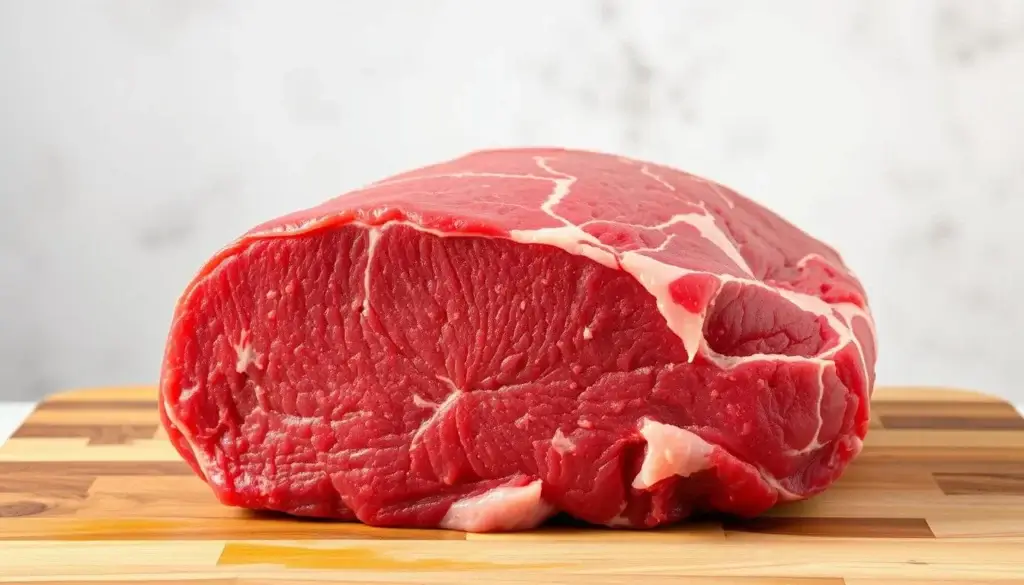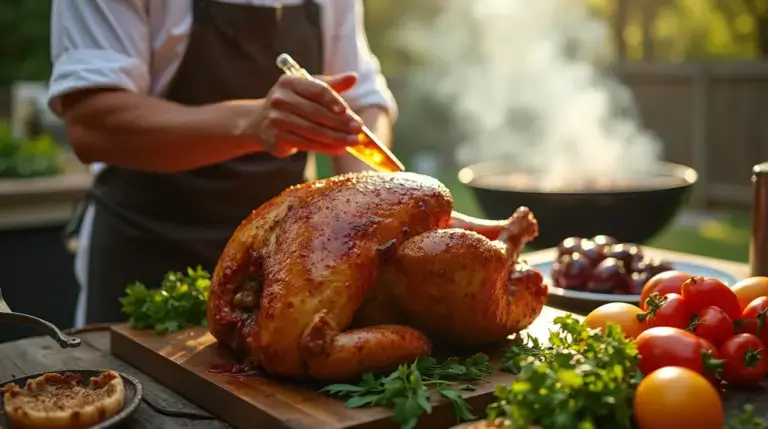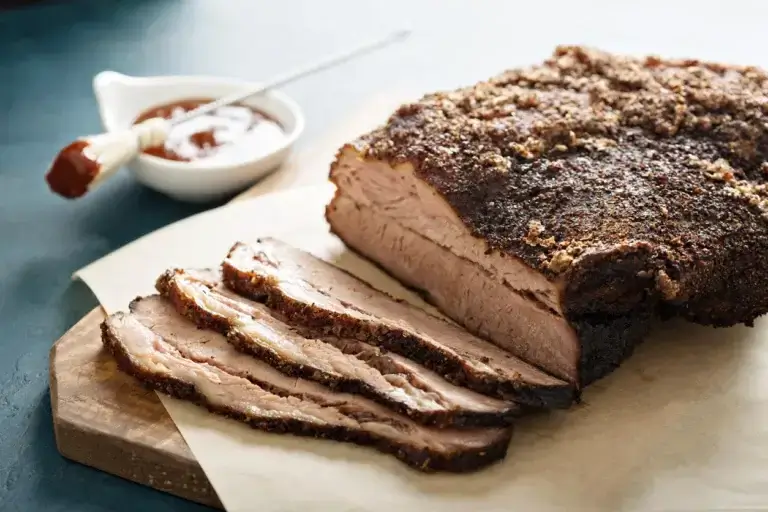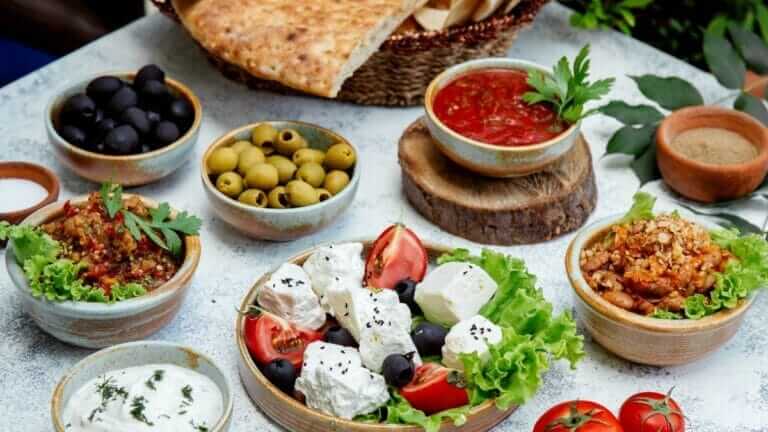Best Seasoning Tips for Beef Bottom Round Roast
Table of Contents
Learning to season a beef bottom round roast is key. This affordable cut is a hidden gem in your kitchen. With the right spices and techniques, even the toughest beef bottom round roast can become tender and delicious. Let’s see how seasoning can turn this often-overlooked meat into a family favorite.
Key Takeaways
- Seasoning transforms the beef bottom round roast from tough to tender and flavorful.
- Key spices like garlic, rosemary, and paprika enhance its natural taste.
- Proper timing and methods matter as much as the seasonings themselves.
- Brining or marinating softens the meat’s texture.
- Simple steps make this economical cut restaurant-quality.
Understanding the Beef Bottom Round Roast Cut
Before you start seasoning or cooking a beef rump roast, it’s good to know this. This cut comes from the cow’s hind leg. It is a muscle that works hard, but it can be tough if not cooked properly.
What Makes Beef Bottom Round Roast Unique

This cut’s dense muscle fibers come from the cow’s movement. This makes it naturally tough. Unlike fattier roasts, it doesn’t have marbling, so keeping moisture in is crucial.
Using beef round roast cooking tips is essential. The lean meat does best with slow, low-heat cooking to soften fibers.
Why Proper Seasoning Matters for This Cut
Seasoning is more than just adding flavor—it’s a technique. Salt helps draw out moisture, creating a crust that keeps juices in. Herbs and acids in marinades break down proteins, making the meat softer.
Without the right seasonings, the roast can become dry or tasteless.
Common Challenges When Cooking Beef Bottom Round Roast
- Dryness: Overcooking or under-resting strips moisture.
- Toughness: Skipping slow cooking methods leaves fibers tight.
- Bland flavor: Missing key spices lets the meat’s gaminess overpower.
Mastering these basics can turn this budget-friendly cut into a favorite. Stay tuned for the next section’s seasoning strategies to tackle these hurdles!
Essential Spices and Herbs for a Flavorful Round Roast
Choosing the right spices is key to a great beef bottom round roast. Start with garlic, rosemary, and thyme. These herbs bring a rich, earthy flavor that complements the roast’s mild taste. Black pepper adds a sharpness, and salt helps keep the meat moist.
- Classic blend: 1 tbsp garlic powder, 1 tsp dried rosemary, 1 tsp thyme, 1 tsp black pepper, mixed with 2 tbsp salt.
- Smoky adventure: Blend 1 tbsp smoked paprika, 1 tsp cumin, and a pinch of cayenne for a bold twist.
- Coffee rub: Mix instant coffee grounds with brown sugar and chili flakes for rich, savory complexity.
It’s all about balance. Use lemon juice or apple cider vinegar to tenderize the meat. Add red pepper flakes or harissa for a spicy kick. Remember, salt is your foundation—sprinkle it generously but evenly. Start with a small amount and modify to your liking.
For beginners, use 1-2 tablespoons of dry rub for every 2-3 lb roast. This lean cut’s bold flavors make every bite juicy and aromatic. Let these spices transform your cooking beef bottom round roast into a masterpiece.
Seasoning Techniques to Transform Your Beef Bottom Round Roast
Learning how to season your beef bottom round roast can make a huge difference. You can choose from a crusty rub or a tangy marinade. The right choice can make your roast taste better and be more tender. Here’s how to pick and use the best methods.
Dry Rubs vs. Wet Marinades
Check out the table below to decide which method is best for you:
| Technique | Best For | Key Advantage |
|---|---|---|
| Dry Rubs | Quick prep | Caramelizes into a crispy crust |
| Wet Marinades | Deep flavor infusion | Moisture retention |
The Perfect Timing: When to Season Your Roast
- Apply dry rubs 30 minutes before cooking for optimal crust formation.
- Marinate in liquid mixes 4–6 hours max—longer can make meat mushy.
- Brine with saltwater 8–12 hours ahead for ultimate moisture.
Advanced Techniques: Brining and Injecting
Want to elevate your bottom round roast? Here are some expert tips:
- Brine: Mix 1/4 cup salt + 1 cup sugar per quart of water. Submerge meat in fridge for 12 hours.
- Inject: Use a flavor injector to push seasoned broth directly into the meat’s center. Aim for 1–2 syringes worth.
Try out these techniques to find what you like best. Even simple salt applied 24 hours ahead (dry brining) can make a big difference!
The Best Way to Cook Bottom Round Roast After Seasoning

Now that your bottom round roast is seasoned, it’s time to cook it. You can use the oven or a convenience appliance. The best way to cook bottom round roast is with low heat and patience to keep it tender.
For oven roasted bottom round roast, preheat to 325°F. Use the reverse sear method: sear the roast in a hot skillet first, then roast uncovered. Or, cover with foil halfway to keep moisture in. Let it rest 15–20 minutes before slicing against the grain.
Want a hands-off approach? Try the slow cooker. Place your seasoned roast in the crockpot with ½ cup broth. Cook on low 6–8 hours. For Instant Pot, sear first, add broth, and pressure cook on high for 50 minutes, then natural release. Both methods yield fall-apart results.
- Slow cooker: 6–8 hours on low with broth
- Instant Pot: 50 minutes high pressure + natural release
Use a meat thermometer! Aim for 135°F (medium-rare) for slicing or 160°F for shredding. Overcooked meat gets tough, so don’t skip the thermometer. After cooking, let the roast rest to redistribute juices—this step makes all the difference in the final texture.
Remember, how do you cook a bottom round roast effectively? Prioritize slow cooking, proper temps, and resting. These steps transform this budget cut into a restaurant-worthy meal every time.
Conclusion: Elevating Your Beef Round Roast with Proper Seasoning
Mastering the beef bottom round roast begins with the right seasoning. Use dry rubs, marinades, or brines. Add techniques like precise timing and resting to make this cut tender and flavorful. Whether you go for a bold rub or a slow-cooked marinade, let flavors soak in before cooking.
Choose the right seasoning for your cooking method. Oven roasting, slow cooker tenderness, or Instant Pot convenience all matter. Avoid overcooking and skipping the rest period to keep meat juicy and full of flavor.
Don’t be afraid to try new things! Start with classic herb blends or explore global flavors like Asian soy-ginger marinades. Even beginners can do well with these tips. Adjust seasoning to your taste and learn from each attempt. The beef bottom round roast is a canvas for your creativity in the kitchen. Season boldly, cook mindfully, and enjoy the results. Your family will love this hearty dish and ask for it again and again.
FAQ
What is the best way to cook a bottom round roast?
The best method for cooking a bottom round roast is oven roasting. Use low and slow cooking to break down the connective tissue. This makes the roast tender and flavorful. You can also use a slow cooker or Instant Pot for convenience.
How do I season a beef round bottom rump roast effectively?
Seasoning your beef round bottom rump roast can greatly improve its taste. Mix salt, pepper, and herbs like garlic, rosemary, and thyme. For a stronger flavor, add smoked paprika or a coffee rub. Apply the seasoning well before cooking, letting it marinate for several hours or overnight.
What are some common challenges when cooking bottom round roast?
Common challenges include dryness and toughness. This cut is lean with less fat. To solve these issues, season well, use a marinade, and cook at lower temperatures.This helps maintain the meat’s moisture and tenderness.
Should I use a dry rub or a wet marinade for my bottom round roast?
Both dry rubs and wet marinades have benefits. Dry rubs create a flavorful crust, while marinades add moisture and deeper flavors. Choose a dry rub for a crispy exterior or a marinade for extra moisture and tenderness, based on your preference.
How long should I cook my bottom round roast for optimal tenderness?
For tenderness, cook at a low temperature of 250°F to 300°F. Aim for an internal temperature of 135-145°F for medium-rare to medium doneness. Use a meat thermometer to avoid overcooking.
How can I ensure my bottom round roast is flavorful?
For maximum flavor, season well before cooking. Use a marinade or dry rub with spices. Cooking with aromatics like onions and garlic adds more flavor as it roasts.
What’s the best method for slicing a bottom round roast?
Always slice against the grain for tenderness. This shortens the muscle fibers, making each bite more tender. Let the roast rest for 10 to 15 minutes before slicing to keep its juices.







